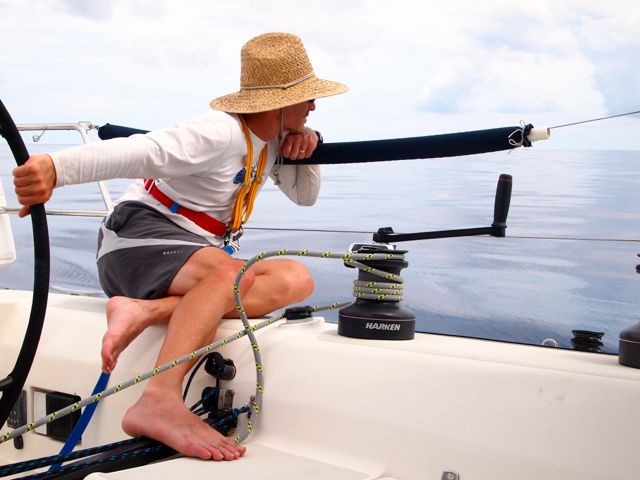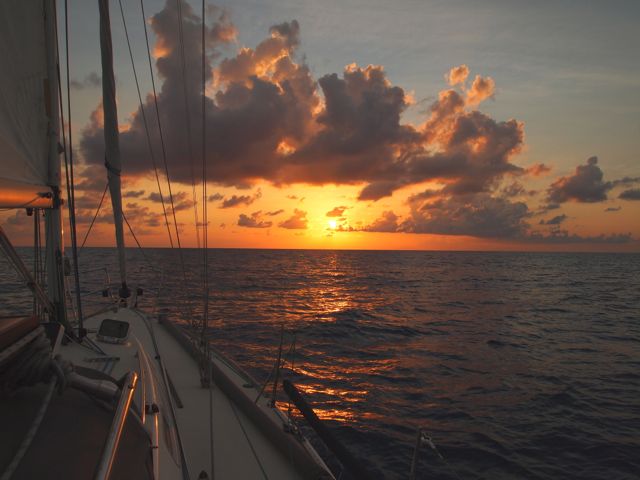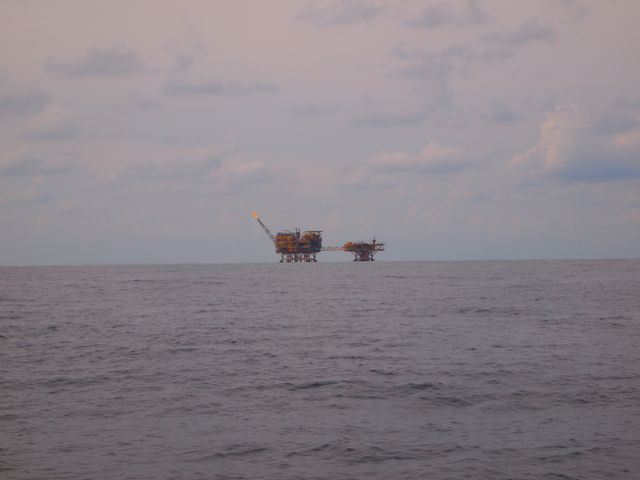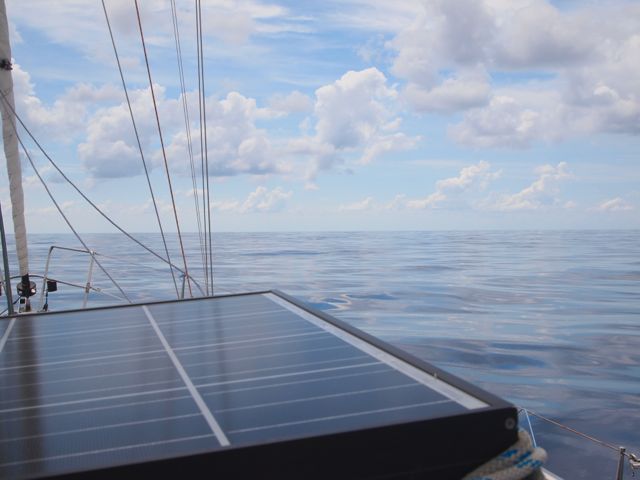Florida to Texas – 96 hours of wheel time

After bidding our friends who had come to spend a few days in the Florida Keys with us good-bye, we returned to Shearwater and quickly put her in passage-making mode: dinghy stowed, hatches sealed, safety gear accessible, jacklines and harnesses ready. We left Marathon at 4pm, at high tide since the access channel was on the shallow side. The wind was breezy at 15+ knots, and we were looking forward to a fast passage to Key West and beyond.
After being in Florida for nearly a week, we expected daily squalls – unpleasant and unpredictable. Our experience in Florida is that many of them pack a huge punch with wind. The first day sailing with our friend out of North Palm Beach had seen a small squall catch us, with the wind quickly rising to over 30 knots. As we settled in to our passage-making routine, the afternoon was setting up its squalls for us to deal with, and pretty soon, we were surprised by sustained winds in the high 30’s and gusts over 40 knots. With a lee shore, we were suddenly not as easily able to deal with the situation safely by simply bearing off and riding the rollercoaster downwind. We furled the jib as well as we could, but with the wind pressure on the sail, we were unable to furl it completely. The resulting flogging sail and howling wind made the situation seem even more ominous, but eventually, like all squalls, the winds eased. During the windier part of the storm, we passed another sailboat that had opted to anchor in the middle of Hawk Channel to wait out the excitement and hailed them on the VHF to make sure all was well (all was).
Our first evening passed by with several squalls engulfing us – we decided that it might not be a bad idea to anchor in Key West when we arrived, to allow us to rest and relax before the long push to Texas. When we arrived, however, it was dark, still blowing, with the atypical SW winds pushing waves straight into the anchorage and quite apparent that there were many boats in the anchorage areas. The idea of anchoring in the breeze in tight spaces, coupled with the fact that the water was actually deeper than we had been anchoring in previously, helped us conclude we would be better off continuing on through Northwest Passage, where we could navigate safely and with ample searoom to keep the squalls at our back. We were also able to move more and avoid some of the squalls, which was much better than dealing with the gusts, lightning and rain in the dark.
Our second day handed us the challenge of the trip, as our autopilot stopped functioning correctly. It turned out that our dinghy foot pump hose slipped between the steering cables and quadrant making it impossible to turn the wheel one direction. The autopilot, not knowing any better, just kept continuing to push, until eventually the high current draw blew an internal fuse in the autopilot computer – a fuse that can only be replaced at the factory. Damn. On reflection, why isn’t there a breaker in the wiring between the computer and ram that is smaller than the internal fuse? We’ve never seen this mentioned, but it seems like an obvious addition now. As it was, we would be hand-steering for the remainder of the trip – 96 more hours. We chose to do 2-hour shifts, round the clock. The good part – we’re better drivers now than we were before. The bad part – hand-steering kind of stinks.
A few hours after resigning ourselves to not having an autopilot, we discovered that all of our satellite phone minutes had evaporated mysteriously – so we would be out of contact for the duration of the trip (we left Marathon with 60 minutes, so “mysteriously” is the appropriate word). This is not the end of the world, but it was frustrating to us, as we did not want anyone else to be worrying about us since the daily emails would not be arriving. Sigh.
Our next challenge showed up the following day when the newly installed anemometer decided to stop working – we saw the same “FAIL” message that had appeared when our old one broke off completely. The unit remained intact on the masthead, though, so we are not sure what the issue was. This setback meant that driving was made even a little more exciting because we had to use the Windex to verify wind direction (for example, when we sail close to the lee and are trying to avoid an accidental gybe) – our necks got sore pretty quickly.

The sunsets never failed to amaze, although our evening enjoyment of them lasted rather briefly…since we had to keep a lookout for night-time squalls.
The following days passed – lots of adverse current, too much sun, tossing spoiled food, motoring much more than expected…but some things improved – our driving was getting better, the refrigerator seemed to be cooling some of the food better and we found a gallon of spring water at the bottom of the refrigerator that was ice cold. We saw a sea turtle and never grew tired of watching the flying fish effortlessly zoom across the surface of the water. The squalls changed a little, too – much more rain and less intense wind (max 25 knots instead of 40 knots – we saw 40 knots or more 5 different times this trip before the anemometer stopped working). However, we were beginning to grow concerned about our fuel levels – for the entire trip, the weather had not followed our expectations, causing us to motor much more than we had anticipated. We made the decision to change our destination to Galveston Bay from Corpus Christi after realizing that our ETA would be much later than we had told family (and without being able to explain why, we did not want anyone to come out looking for us). And, as mentioned before, the hand-steering still pretty much stunk.
Our last 24 hours of sailing started out disappointingly with glassy water and the drone of the engine. The idea that we might be so close to finishing the delivery, but could still run out of fuel and be stuck out for another night of squalls was unpleasant to say the least. However, the wind began to fill in, and we put up our gennaker to take advantage of every wisp of wind available. At dusk, we took the sail down (the previous evening’s crisis of pulling it down in the dark reinforced being prudent), and then set up the genoa on our carbon whisker pole – the sailing was amazing. The helm was light, and the boat very well balanced.

An oil rig in the gulf – this was in approximately 400 feet of water. From the distance we are at, it looks small, but the structure was quite large.
Soon enough, we were at the approach to Galveston, where the cell phones suddenly lit up with service so that we could text our family that we were fine. Knowing that we’d have enough fuel to get to a marina, that we’d be done hand-steering soon…what a feeling!
We finally were able to anchor 6 hours later (it was nearly a 30-mile trip from the entrance to Clear Lake located south of the city of Houston, where we planned to find a marina), keeping non-stop company with huge ships in the Houston Ship Channel. The wakes were incredible, and we later learned that some people surf the wakes of the commercial vessel traffic on the weekends. After a few hours of sleep at anchor in Galveston Bay, the sun came up and we proceeded to Seabrook, where we’ll keep Shearwater for a few months. We’ll likely race the point-to-point Harvest Moon Regatta which will end in Corpus Christi, and then get to explore that area (both help make the decision to divert to Seabrook very easy).
We’ve had our share of good luck and good winds with Shearwater so far. This trip our luck definitely ran out. Between running aground between channel markers in a channel specifically recommended for our 7’ draft, losing the autopilot because a hose got in the way, losing the sat phone minutes for no apparent reason (I suspect the provider screwed up as we see now an email telling us we are out of minutes, but the email is addressed to someone else), losing the anemometer and wind direction (again), the extreme heat of summer because of the 2-month shipping delay in getting Shearwater back from Europe, the strange wind direction for Gulf of Mexico, the days of motoring…it just wasn’t our time. Hopefully, we packed all the unfortunate incidents into one go. All in all, though – we did fine.
4 comments
Leave a ReplyCancel reply
Sign up to receive blog updates


In spite of some things going wrong, I am THRILLED to read of your Shearwater travels again. Once again, I am riveted and feel I’m on her deck with you……THANKS!! Sure do miss you guys.
I have been watching you for months, its great. yesterday i looked at a J120 to do a similar trip but the other way around from Europe. Good look in Texas, try out the Lakewood yacht club, they seem really nice people when I was there a couple of times.
Thanks for all the notes and photos, very special.
Simon in the UK
Simon – thanks for stopping by! We’re definitely planning on trying to explore the area – already found “Tootie’s” which was a pleasant surprise – a great restaurant in the vicinity.
Hey you guys! This is Smackdaddy from the sailing forums (Sailnet, Sailing Anarchy, etc.). We were out on Galveston Bay on Saturday on our Hunter 40, S/V Dawn Treader. As we were coming out of the channel into the bay I saw a Jboat about 60′ to port with the name “Shearwater”. I’d come across you guys on SA with the crazy video of you guys trying that Portugal run (a serious BFS for sure) then wisely deciding to turn back. At first I was thinking – no freakin’ way. But as you raised the main I knew it was you guys. VERY, VERY COOL!
Welcome to Texas and its crazy maze of unlit rigs. How long are you guys staying?
Steve